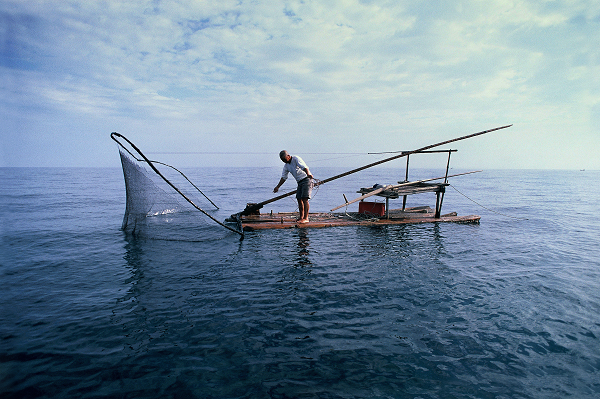| |
 |
|
| A traditional Jeju boat called Taewoo. Photo by Kim Soo-nam and courtesy of Sanjicheon Gallery |
In the picture “Jeju Mahun Gut,” a shaman stands knee deep in ocean water. Surrounded by rocks and carrying the possessions of a dead man, he passes the soul of the deceased into the sea surrounding Jeju. This photo perfectly combines the themes of the first exhibition at the Sanjicheon Gallery in Jeju City “Asian Seas Through The Lens Of Kim Soo-nam.”
Beginning in the late 1970’s and early 1980’s Kim Soo-nam’s work presents an intimate look at Jeju's shamanistic culture. A culture that, even back then, he knew was at a significant risk of being lost to the ongoing onslaught of modernization.
“My dream is that my work can be one witness and one document the shamanism, now the faith which needs to be preserved at the risk of disappearance.”
Kim Soo-nam from the book “Asia, living faith.”
The exhibition brings together much of the Jeju-born photographer’s work and focuses it on the themes of life, belief, and festivals in locations surrounded by the sea.
On April 22, 1970, the then President of Korea Park Chung-hee launched a political initiative called the Saemul Undong (New Community Movement) that aimed to modernize the South Korean Economy. While improving much of the infrastructure and living standards of rural South Korea, these modernization attempts stretched to attempting to destroy the traditional beliefs of Korean Shamanism.
| |
 |
|
| The Harosandang Yeongdeunggut. Photo by Kim Soo-nam and courtesy of Sanjicheon Gallery |
Kim Soo-nam’s photo’s, therefore, stand as an early attempt to protect and document these traditional practices, also known as “gut,” before they were completely lost. In the exhibition, photos of shamanistic rituals being performed show scores of people gathered together. Plentiful food and people in shamanistic dress mix with others in suits and dresses. Clearly, at this time, these shamanistic practices had found their place in the modern world.
The photos stand not just as a glimpse into the traditions of Jeju, but also into a look at the island as it was a mere 30 years ago. Not many places have gone under such a significant change in such a short period time.
“What am I supposed to express and reveal through Gut as a photographer? I believe my work may exist to unveil life and death, sufferings and ecstasy, frustration and hope, and maybe to show them in an extremely exotic and touching way.”
Kim Soo-nam from the book “Asia, living faith.”
There are, of course, many recognizable images in the photos. Groups of haenyeo pose for pictures as they make their way out to sea, older fisherman repair the boats that they use to earn their livelihoods.
The venue of the exhibition is in itself a link to the past. Actually made up of two old motels, connected in the middle, the building has been renovated into a new art gallery while still keeping some of the character of the original building. Especially noteworthy is the huge chimney that stands tall above the rest of the building, a remnant of the sauna that the motel kept on its bottom floor.
| |
 |
|
| The Sanjicheon Gallery is made up of two renovated motels. Photo by Kim Soo-nam and courtesy of Sanjicheon Gallery |
The themes of life, faith, and festival are separated by floor in the gallery. The pictures in life show a way of life that is ending, faith shows the ceremonies and beliefs of these traditional belief sets, while festivals shows the traditional festivals that are often a part of this way of life.
While some of Kim Soo-nam’s work focuses on Jeju, much of his photography was taken in other places. In fact, his mission to preserve rituals at risk of dying out brought him to various countries throughout Asia including Japan, the Philippines, and India.
Some photos show locations similar to Jeju, such as those taken on the island of Okinawa. Here the blue seas and white sands mean if you didn’t look at the caption you wouldn’t think it wasn’t taken on Jeju.
Other photos show the life and beliefs of countries further away. However, all the photos are bound by the artist's desire to depict a belief set that will perhaps not survive for much longer.
The exhibition is the first to be held at the Sanjicheon Gallery and it will run until March 31.
Kim Soo-nam: Biography
Kim Soo-nam was born on Jeju in 1949. He graduated from Yonsei University before becoming a photographer for the Donga Ilbo newspaper. His early work focused on the “Gut” rituals of Jeju and Korea while later in his life he spent much of his time traveling and taking photos. He passed away in Chiang Mai in Thailand in February 2006.
|























